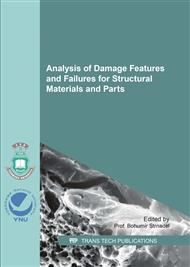[1]
M. Holzmann, I. Dlouhy, M. Brumovsky: Measurement of fracture toughness transition of CrNiMoV pressure vessel steel using pre-cracked Charpy specimens, Int J Pres Ves Pip, 76, 1999, 9, 591-598.
DOI: 10.1016/s0308-0161(99)00041-1
Google Scholar
[2]
I. Dlouhy, V. Kozak, L. Valka et al.: The susceptibility of local parameters to steel microstructure evaluated using Charpy type specimen, J Phys IV, C6, 1996, 205-214.
DOI: 10.1051/jp4:1996620
Google Scholar
[3]
T. L. Anderson, R.H. Dodds: Specimen size requirements for fracture toughness testing in the transition region, J Test Eval, 19, 1991, 123-134.
DOI: 10.1520/jte12544j
Google Scholar
[4]
I. Dlouhy et al.: Micromechanical aspects of constraint effect at brittle fracture initiation, in: The Transferability of Fracture Mechanical Characteristics, I. Dlouhy ed., Kluwer, (2002).
DOI: 10.1007/978-94-010-0608-8_5
Google Scholar
[5]
T. Linse, M. Kuna, H. W. Viehrig: Quantification of brittle-ductile failure behavior of ferritic RPV steels using the Small-Punch-Test, Mater Sci Eng A, 614, 2014, 136-147.
DOI: 10.1016/j.msea.2014.05.095
Google Scholar
[6]
T. Smida, J. Babjak, I. Dlouhy: Prediction of fracture toughness temperature dependence from tensile test parameters, Kovove Mater – Met Mater, 48, 2010, 6, 345-352.
DOI: 10.4149/km_2010_6_345
Google Scholar
[7]
R. H. Dodds Jr, C. Ruggieri, K. Koppenhoefer: 3D constraint effects on models for transferability of cleavage fracture toughness, In: Fatigue and Fracture Mechanics, ASTM STP 1321, Underwood, MacDonald & Mitchell, Eds., 1997, 179-197.
DOI: 10.1520/stp12308s
Google Scholar
[8]
X. Gao, R.H. Dodds Jr.: An engineering approach to assess constraint effects on cleavage fracture toughness, Eng Fract Mech, 68, 2001, 263-283.
DOI: 10.1016/s0013-7944(00)00102-8
Google Scholar
[9]
F. Minami, M. Ohata, et al.: Method of constraint loss correction of CT fracture toughness for fracture assessment of steel components, Eng Fract Mech, 73, 2006, 14, 1996-(2020).
DOI: 10.1016/j.engfracmech.2006.03.013
Google Scholar
[10]
L. Stratil, F. Siska, I. Dlouhy, M. Serrano: The application of miniaturized three-point-bend specimens for determination of the reference temperature of JRQ steel, in Pressure Vessel and Piping, ASME conference, Boston, 2015, 6. p.
DOI: 10.1115/pvp2015-45706
Google Scholar
[11]
L. Stratil: Determination of fracture mechanical characteristics from sub-size specimens, PhD Thesis, 2014, Brno University of Technology.
Google Scholar
[12]
ASTM E1820-15, Standard Test Method for Measurement of Fracture Toughness, 2015, Annual Book of ASTM Standards, ASTM International, West Conshohocken, PA, (2015).
Google Scholar
[13]
ASTM E1921-13, Standard Test Method for Determination of Reference Temperature, T0, for Ferritic Steels in the Transition Range, ASTM International, West Conshohocken, PA, (2013).
DOI: 10.1520/e1921-22
Google Scholar
[14]
M. Serrano: Evaluación computacional del efecto de la pérdida de constricción en la tenacidad de fractura de la vasija de reactores nucleares, PhD Thesis, 2007, Polytechnical Univ. Madrid.
DOI: 10.20868/upm.thesis.1012
Google Scholar
[15]
C. Berdin, J. Besson, S. Bugat, et al., Local Approach to Fracture, École des Mines de Paris, 2004, p.442.
Google Scholar


